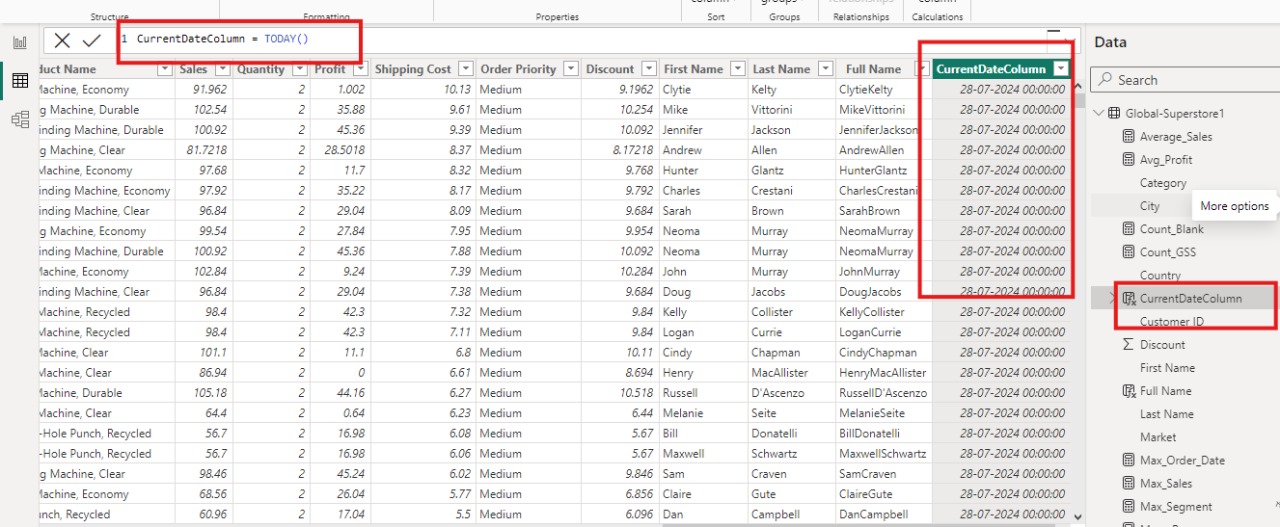
Automate Date Calculations in Power BI with the TODAY Function
Jul 28, 2024
Automate Date Calculations in
Power BI with the TODAY Function
In today’s blog post, I’ll discuss how to effectively
use the TODAY function in Power BI. This function will empower you to enhance
your data models and reports by providing the current date dynamically,
allowing for more accurate and timely data analysis and insights.
Power BI offers a robust set of DAX (Data Analysis
Expressions) functions that facilitate complex calculations and data
manipulation. Among these, the TODAY function stands out as a simple yet
powerful tool for working with date-related data. In this blog, we will explore
the TODAY function, its usage, and practical examples to help you effectively
utilize it in your Power BI reports.
What is the TODAY Function?
The TODAY function in DAX returns the current date in
the datetime format. It’s a straightforward function that doesn’t require any
arguments. This makes it particularly useful for creating dynamic date-based
calculations and reports that update automatically as time progresses.
Syntax
TODAY()
Key Characteristics of the
TODAY Function
No Arguments Needed: The
TODAY function doesn’t require any parameters, simplifying its usage.
Returns Current Date: It always
returns the current date based on the system date and time.
Date Type: The
return value is in the datetime format, which includes both the date and time,
although the time portion is always set to 00:00:00.
Practical Applications of the
TODAY Function
1. Creating Dynamic Date
Filters
One of the common use cases for the TODAY function is to
create dynamic date filters. For instance, you might want to filter your data
to show only the records from today or within the last 7 days.
Example: Filtering Data for
the Last 7 Days
Last7Days =
IF(
'Table'[Date]
>= TODAY() - 7 && 'Table'[Date] <= TODAY(),
"Last 7
Days",
"Other"
)
2. Calculating Age
Another useful application is calculating the age of
items, such as the age of a customer based on their birthdate.
Example: Calculating Age
Age =
DATEDIFF(
'Table'[Birthdate],
TODAY(),
YEAR
)
3. Highlighting Today's Data
You can also use the TODAY function to highlight today’s
data in your reports. This is particularly useful in dashboards where you want
to draw attention to current day metrics.
Example: Highlighting Today's
Sales
IsToday =
IF(
'Sales'[Date]
= TODAY(),
"Today",
"Other"
)
Visualizing Data Using the
TODAY Function
Once you have created measures and columns using the
TODAY function, you can leverage them in your visualizations. Here are a few
examples:
- Line Chart: Plot
sales over time and use conditional formatting to highlight today's sales.
- Table: Create a table that shows key
metrics with a column indicating if the data is from today.
- KPI Visual: Use
the TODAY function to show today’s sales as a KPI, comparing it against
historical data.
Tips and Best Practices
- Refresh Considerations: Remember that
the TODAY function relies on the system date and time. Ensure your data
refresh schedule aligns with your needs to keep the date calculations
accurate.
- Combine with Other Date Functions: The TODAY function can be combined with
other DAX date functions like DATESYTD, DATESMTD, or DATEADD for more
complex date calculations.
- Timezone Awareness: Be
mindful of timezone differences, especially if your data spans multiple
regions. The TODAY function will use the timezone of the system where the
report is being viewed.
Example of TODAY FUNCTION
 Conclusion
Conclusion
The TODAY function in Power BI is a versatile and easy-to-use function that can significantly enhance your date-based calculations and reporting. Whether you’re filtering data dynamically, calculating age, or highlighting today’s metrics, understanding and utilizing the TODAY function will help you create more responsive and insightful Power BI reports.
For more detailed guidance and in-depth training, visit our training here.

